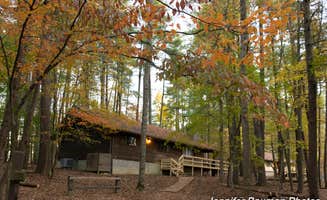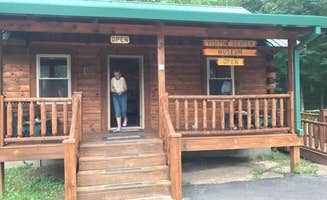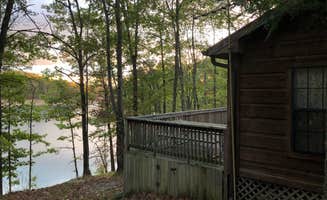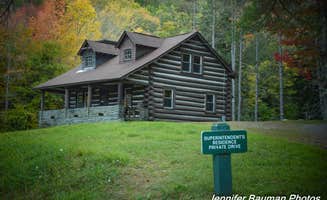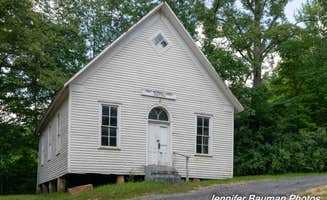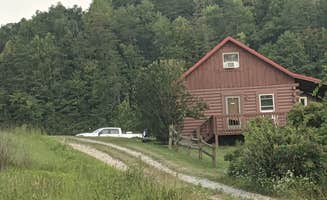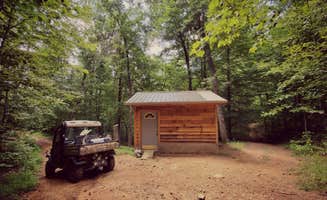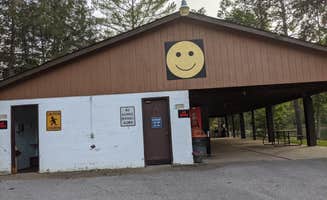Cabin camping near Cedarville, West Virginia offers rustic accommodations in the Allegheny Highlands region where elevations reach 3,000 feet. The area receives significant rainfall throughout the year, creating lush forest conditions and numerous streams. During peak summer months, temperatures typically range between 55-75°F, with cooler evenings making campfires a practical necessity rather than just ambiance.
What to Do
Waterfall exploration: 2-mile hike required from Holly River State Park Campground. The park features multiple waterfall trails for various hiking abilities. "Beautiful tent sites along the creek! I was there in late summer, but I plan to return in late spring when the rhododendrons would be in bloom," notes one visitor to Kumbrabow State Forest. Waterfall enthusiasts can access several cascades by hiking the trails.
Fishing opportunities: Multiple stocked areas throughout the region. Many campgrounds offer fishing access directly from cabin areas. At Camp Holly, "The campground has a shop where you can buy necessities you may have forgotten, ice, snacks and fishing gear," according to a camper. The rivers and lakes in the area support bass, catfish, and trout depending on the location.
Rail trail access: North Bend Rail Trail spans 72 miles. This converted railway offers biking and hiking through tunnels and across bridges. At River Run Campground, visitors note the convenient trail access: "This humble campground is located on the 'Haunted' North Bend Rail to Trail. It was easy check in with a friendly staff."
What Campers Like
Off-grid experience: Rustic cabins with limited modern amenities. Many visitors appreciate the disconnection from everyday technology. At Kumbrabow State Forest, campers value the remote location: "This historic recreation area, carved into this 9,500-acre forest by the Civilian Conservation Corps in the 1930's, is a wonderful place to unplug and unwind."
Well-maintained facilities: Clean bathrooms despite remote locations. Even in more primitive settings, visitors note the upkeep of essential facilities. "Bathrooms and showers were relatively clean and accommodating," reports a visitor to Mountwood Park Family Campground. Regular maintenance seems to be a priority at most cabin locations in the region.
Scenic waterfront locations: Many cabins positioned near streams or lakes. Water features enhance the camping experience at numerous sites. "We stayed in space #7, located next to Mill Creek, where I enjoyed the relaxing sound of this gurgling stream all night long," writes a Kumbrabow visitor. These water features provide both ambiance and recreational opportunities.
What You Should Know
Limited connectivity: Cell service varies significantly by location. Most cabin locations have minimal to no coverage. At Stonewall Resort State Park Campground, visitors find more reliable connections, while deeper forest locations have none. "No cell coverage or Wi-Fi, 2 mile drive to bath house," notes one Kumbrabow State Forest camper.
Access challenges: Many cabin areas require navigation on unpaved roads. Some locations demand careful driving, especially after rain. "Access is by about 6 miles of dirt/rock road," mentions a Kumbrabow visitor. Four-wheel drive vehicles may be necessary for accessing the more remote cabin locations.
Seasonal operation: Most cabins close during winter months. Operating seasons vary by location but generally run April through October. Some properties like Flatwoods KOA operate year-round but with limited winter services.
Variable amenities: Research specific cabin features before booking. "The road to 4 was horrendous to be pulling a camper. Had to use 4Low to creep out," reports a visitor to Mountain Lake Campground and Cabins, highlighting the importance of understanding access conditions.
Tips for Camping with Families
Playground proximity: Select sites near recreational facilities. Several campgrounds offer dedicated children's areas. "Our camp site was right next to one of the playgrounds and that was definitely a plus! Our little boy could play while we watched from our site," shares a Mountain Lake Campground visitor.
Wildlife viewing opportunities: Morning and evening animal sightings common. Many cabin areas host diverse wildlife. "Lots of deer, we even saw a mother with 2 fawn!" reports a family at Mountain Lake. Bringing binoculars enhances these viewing opportunities.
Activity planning: Weather patterns affect outdoor schedules. The region experiences frequent rain, especially in valley locations. "Every morning and every night it rained which made it difficult to swim and fish. The park workers said this is common year round," notes a Holly River visitor.
Water safety considerations: Supervise children near streams and lakes. Many cabin sites position near water features that can be both recreational assets and safety concerns. Rippling Waters Church of God Campgrounds offers "a pull thru site by the lake, it had to be about 100 yards long and nicely graveled," providing spacious areas for families.
Tips from RVers
Site selection: Research specific site dimensions before arrival. Some cabin and RV areas have tight turning radiuses. "Some spots a little tight for bigger camper we have a 30' but we were okay," notes a camper at Holly River State Park.
Power considerations: Voltage fluctuations reported at some locations. Surge protectors recommended for RV electrical systems. "My surgeguard shut off the power in the evening due to high voltage. It was showing 137 volts at one time," reports a visitor to Stonewall Resort.
Water quality varies: Filtration recommended at certain campgrounds. Some locations have heavily chlorinated or mineral-laden water. "Make sure you run the water lines to clear them out before hooking up. The water quality is very poor," advises a Flatwoods KOA visitor.
Leveling challenges: Bring adequate blocks for uneven terrain. Many cabin and RV sites require significant leveling. "Very unlevel spot. Not sure if they are all like this, but it's a big ugh," reports a Flatwoods KOA camper.


